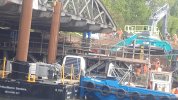I was expecting the support to be spread out more, rather than using just the few points chosen on a single cross-beam. Those points were never intended to be used as bearings, and the flanges of the cross-beams are particularly vulnerable to rusting. But the central support, from what those pictures show, is bigger, so perhaps it does do that.
And doesn't the whole platform with its 24 piles, and the structure on top, look rather oversized for those spindly little jacks that are doing the work? The total weight on them isn't that much anyway: about two-thirds of the span's weight, say 110 tons.


